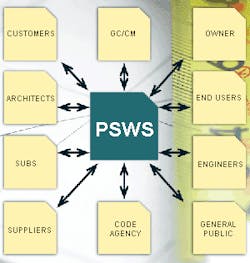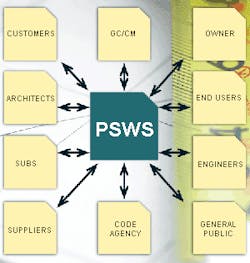Using Project-Specific Websites to Manage Construction Project Delivery
By Robert F. Cox
Managing information continues to be a critical success factor for construction operations.
Given the highly complex, fast-paced, and dynamic nature of the construction process, it has become evident that, in order to complete a project, all correspondence must be maintained in a fashion to support effective utilization and communication. Increased demands on all parties key to the building process place construction at a critical point in addressing communication problems plaguing the industry - many of which are not new to practitioners. One way to address this situation is via a project-specific website (PSWS).
PSWSs are Web-based applications that take advantage of the Internet to provide a collaboration platform to perform typical project-management tasks, such as storing and managing project information. They allow all necessary groups (contractors, engineers, architects, etc.) to have controlled access and automated distribution of information. Through the integration of the Internet and project-management systems, tasks can be accomplished better, faster, and cheaper. In addition, these Web-based systems offer historical archives that are easily searchable for retrieval and reference purposes. Improving communication between project participants, increasing accountability, and streamlining the development process from site selection to design, construction, and operation, PSWSs reduce the costs incurred by change orders, claims, and record maintenance, as well as minimize or eliminate delays.
The Survey Says...
The results of a recent survey of owners by Raleigh, NC-based FMI Corp. and McLean, VA-based Construction Management Association of America - conducted specifically about the construction process from the building owner's perspective - indicate that owners continue to express concerns with communication and collaboration issues when it comes to construction projects. Effective communication was rated as the top change that "will most significantly contribute to improving the quality of the project-delivery process." Specific project-delivery concerns identified in the survey include schedule and cost issues, each of which can be further categorized into problems associated with coordination, communication, and accountability.
Owners indicated that actual time requirements for "key phases in construction" were 20- to 50-percent longer than planned, causing a ripple effect on projects in terms of delays. Owners identified these five reasons for project-cost overruns (many of these reasons could be avoided through more effective management and control of the construction process):
- Incomplete drawings.
- Poor pre-planning process.
- Escalating cost of materials.
- Lack of timely decisions.
- Excessive change orders.
There are also various issues surrounding coordination, collaboration, and communication challenging owners and causing confusion on projects. The vast majority of these issues can be addressed by a properly established and effectively utilized PSWS.
The Power of Collaboration & Communication
The need to improve project communication and collaboration among construction players has become one of the major reasons that projects run over budget.
Many projects have reported gaining greater benefits from those technology applications that help them connect their partners throughout all phases of a project, including conceptual design, preconstruction management, construction, and operations and maintenance, utilizing a totally integrated platform or Web-based collaboration tools.
Some owners still think that collaboration is too complicated, too costly, or not suitable for their organization. This is most likely a result of being exposed to PSWS technology more than 5 years ago. In other words, these non-believers have not seen nor experienced the user-friendly nature of the newest PSWS systems. The transformations made to PSWS application technology in the past 5 years is likened to the conversion of software from DOS- to Windows®-based programming.
Among the reasons and perceptions that owners have for avoiding the adoption of project-collaboration software are the questions of interoperability and interchangeability. Many owners will require vendors to provide interoperable/interchangeable software in the future (if not right now). However, given the fragmented and proprietary nature of many project-management solutions, some software applications have been developed without any interoperability or interchange focus. It's unlikely that genuine, industry-wide interoperability will be accomplished in the near future; in the meantime, owners desiring true interoperability between their own internal systems and those of their entire project team will likely need to secure project-specific websites to link the outputs of different software systems together. On a PSWS, data interchange can occur in a vast variety of formats; some even offer the capability to review files without needing the native application.
Use of a Web-based project-management system improves overall coordination, collaboration, and communication in a variety of ways. First, by having a central portal of the most up-to-date project information for all participants provides the opportunity to access whatever is needed to perform individual project responsibilities. Secondly, the ability for PSWS participants to retrieve archived historical documents increases their ability to understand project issues as they arise and are resolved. Thirdly, project participants can easily see which participants might be the bottlenecks, holding up a decision or a vital piece of project information that is needed before continuing. This accountability raises awareness for all team players and increases the likelihood of staying on top of the situation and providing timely, complete, and effective coordination, collaboration, and communication.
Using a Web-based portal for all project information from conceptual stages through construction, occupancy, and maintenance allows project players the opportunity to access and utilize information that is critical to the functionality of their role in the project. In an open-information environment, by making sure that everyone on the team has access to the information needed to perform tasks, any excuses for non-performance are eliminated. In addition, such technology is a mechanism for project participants to "meet and interact" with all other members - any time and any place - as long as they have access to the Internet.
A collaborative PSWS can provide participants with instant e-mail notification regarding critical documents and process items. Users can often select and place various prioritized notification levels across different documents and folders within the entire PSWS. A participant can have subscriptions to any or all files and folders, and can choose to receive instant notification if any document is accessed, updated, or created by another participant. If the user does not want instant notification, they can instead choose to receive daily summaries of all actions that took place within a subscribed folder. This component allows the PSWS user to subscribe to their most-important file folders for instant notification so that they are immediately notified via e-mail if a new file has arrived or has been reviewed, redlined, downloaded, or accessed by another project participant. Such an action provides the user assurance that they are part of the information loop and process flow - whether they are logged in or not. This allows the user to best utilize his/her time and take action on other projects simultaneously while awaiting notification.
Having the capability to fully collaborate with all key players (designers, regulatory agencies, contractors, etc.) throughout the programming and design stages provides for improved drawings and final design that better meets needs and expectations. Use of a PSWS allows for information to be stored and shared as decisions are made and plans are revised. Document sharing includes archived "mark-up" versions of the drawings, giving participants the ability to propose drawing revisions on a marker board set up with multiple participants reviewing, marking, and communicating on the same view file. Such components give the entire project team the interaction and traceability to effectively complete the design process, gaining incorporation of all necessary revisions into the designs as they are being developed on the fly. Even the local building code enforcement agency can be involved in this process, identifying and heading off potential delays in final approval and permitting.
Big Payoffs
In a PSWS, all project-related documents, versions, mark-ups, correspondence, design and engineering, and, ultimately, all of the "whats, whys, whens, and hows" for everything that has taken place on the project since inception are archived electronically in a single platform that is totally searchable. Everything is at your fingertips to retrace thought processes (with all outcomes documented).
No other technology provides interaction, communication, collaboration, archival data, a project-information continuum, participant reliability, and accountability - all without the need of the native software to review and gain full understanding and awareness of the project. PSWS technology is positioned to make the largest impact on construction project delivery since the introduction of the personal computer.
Robert F. Cox is professor and department head at Purdue University's Department of Building Construction Management, West Lafayette, IN.

